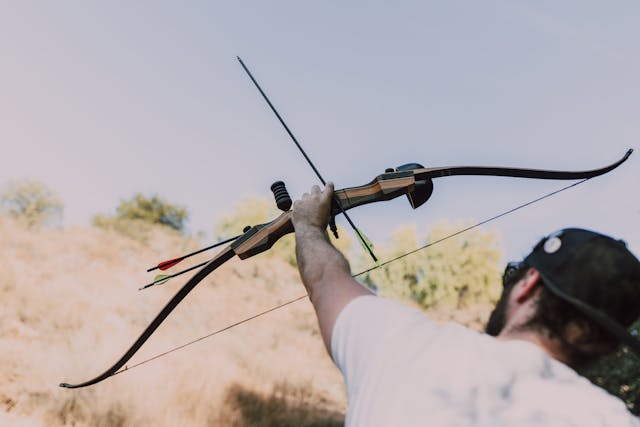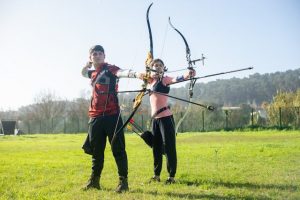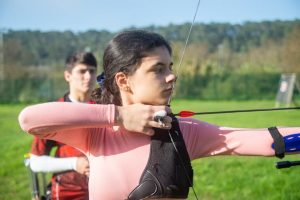
- Recurve bows are celebrated for their adaptability in activities like hunting, target archery, and historical enactments, thanks to their efficient design.
- They boast a storied history and are increasingly embraced in modern recreational activities, blending ancient tradition with contemporary interests.
- This article thoroughly examines recurve bows’ diverse applications, from Olympic precision to the quiet pursuit of game.
In the diverse world of archery, recurve bows hold a special place, striking a balance between ancient tradition and modern precision. These bows, known for their distinctive curved tips which enhance power and efficiency, have been a pivotal part of human history—serving not just as tools for survival but also as instruments of sport and skill.
With archery’s surge in popularity, many enthusiasts and newcomers alike find themselves asking, “What are recurve bows used for?” The answer spans a broad spectrum, reflecting the versatility and enduring appeal of these bows. From the meticulous discipline of target archery to the primal thrill of hunting, recurve bows have adapted to contemporary demands while preserving their historical essence.
This blog post aims to explore the multifaceted roles recurve bows play in today’s world. We’ll delve into their history, understand their mechanics, compare them with modern alternatives like compound bows, and guide beginners on starting their journey in recurve archery. Whether you’re drawn to the elegance of archery as a sport or the practical applications of recurve bows in hunting and beyond, our exploration will illuminate the enduring legacy and evolving relevance of these powerful tools.
Understanding Recurve Bows

Recurve bows are distinguished by their unique design, where the limbs curve away from the archer when unstrung, giving them their characteristic “recurve” shape. This design is not merely aesthetic but serves a critical function in enhancing the bow’s performance.
When drawn, the curves straighten out, storing more energy than a straight-limbed bow would. This additional energy translates into increased power and speed of the arrow upon release, a feature that makes recurve bows highly valued in archery. Their design also contributes to greater efficiency in energy transfer, making them a preferred choice for many archers.
The Anatomy of Recurve Bows
The recurve bow’s construction, typically featuring a riser (the central part where the archer holds the bow) and two detachable limbs, allows for customization and adjustments to fit the archer’s preferences and requirements.
The benefits of recurve bows extend beyond their power and efficiency. The design allows for a more compact bow when unstrung, which can be advantageous for archers traveling or navigating through dense environments, such as hunters in wooded areas.
Compared to straight-limb bows, recurves offer a smoother draw, which helps reduce fatigue and improve accuracy over prolonged shooting periods. This design efficiency has kept the recurve bow at the forefront of Olympic archery, where precision and consistency are paramount.
The History of Recurve Bows
Ancient Roots: The Dawn of Recurve Bows
The recurve bow, a marvel of historical archery, boasts a lineage that traces back thousands of years, standing as a testament to human ingenuity and the enduring quest for improved tools of survival and conquest. Its origins are as ancient as they are widespread, with evidence of recurve bows found in the remnants of the earliest human societies.
This bow was not merely a tool for hunting or an instrument of war; it was a symbol of skill, prestige, and power. The versatility and efficiency of recurve bows made them highly prized among warriors and hunters alike, offering a significant advantage in speed and distance compared to the straightforward design of the longbow.
The Recurve Bow in War, Hunt, and Sport
Throughout history, the recurve bow has been a staple in the arsenals of many formidable cultures, each contributing to its evolution and mythology. The Mongol Empire, renowned for its horseback archery, utilized the compact and powerful recurve bow to devastating effect, allowing them to shoot with remarkable accuracy while on the move.
Similarly, the Ottoman Turks, masters of traditional archery, refined the craft of recurve bow making, enhancing its design for increased power and precision. These archers could unleash arrows with such force and accuracy that they became feared and respected across the medieval battlefield. The design of recurve bows allowed for a higher draw weight without a proportional increase in bow size, making them ideal for use on horseback or in the tight confines of forested terrain.
The Recurve Bow’s Journey Through Civilizations
The evolution of recurve bows throughout history is not just a testament to human ingenuity and craftsmanship but also a reflection of the changing dynamics of warfare, hunting, and sport. From the steppes of Central Asia to the forests of medieval Europe, the recurve bow has left its mark on history, adapting and evolving with each generation.
Today, this ancient tool has found new life in the realms of competitive sports and recreational archery, connecting modern enthusiasts with the rich heritage of traditional archery. The transition from the battlefields of old to the Olympic archery ranges of today underscores the recurve bow’s versatility and enduring appeal. As we draw the string back, we not only prepare to launch arrows but also to connect with a legacy that stretches back through the ages, embracing the spirit of historical archery in every shot.
Modern Uses of Recurve Bows
Hunting

The recurve bow remains a popular choice for hunting due to its effective design, which allows hunters to take down various game animals efficiently. The effectiveness of recurve bows in hunting situations stems from their lightweight and maneuverable nature, making them ideal for use in tree stands or blinds where space is limited and silence is golden.
Hunters appreciate the recurve bow for its quiet operation, a crucial advantage when stalking wary game. Choosing the right bow weight is essential for ensuring that the bow has enough power to ethically and effectively harvest the animal, while the selection of arrows must also be considered to ensure they are suitable for the type of game being hunted.
Regulations regarding recurve bow hunting vary across different regions of the US, with specific seasons and rules governing the use of archery equipment for hunting. It’s important for hunters to familiarize themselves with these regulations to ensure they are hunting legally and ethically. Despite these variations, the core appeal of hunting with a recurve bow—its simplicity, challenge, and connection to a more traditional form of archery—remains strong among enthusiasts seeking a more immersive outdoor experience.
Target Archery

Target archery, governed by organizations such as World Archery, is a competitive sport that tests the precision, focus, and consistency of archers. Recurve bows hold a place of honor in this discipline, especially in Olympic archery, where they are the only type of bow used. The competitive nature of target archery, whether in the Olympics or other international competitions, demands not only physical strength and skill but also mental fortitude, as archers must maintain concentration and control over their technique in high-pressure environments.
This discipline includes various classes and styles, such as recurve and compound target archery, each with its own set of rules and challenges. The recurve division, in particular, showcases the traditional aspects of archery, emphasizing the archer’s ability to synchronize mind and body to achieve perfect shots consistently. The skills required for excelling in target archery—precision, focus, and consistency—are developed through rigorous training and dedication, highlighting the sport’s demanding nature and its appeal to those looking to challenge themselves.
Other Uses
Beyond hunting and competitive target archery, recurve bows find their place in a variety of other applications, enriching the archery experience for enthusiasts of all levels. Historical reenactments often feature recurve bows to bring authenticity to the portrayal of ancient warriors and archers, offering spectators and participants alike a glimpse into the past. Bowfishing, an exciting blend of fishing and archery, allows archers to hunt fish with specialized arrows and equipment, adding a unique challenge and variation to traditional fishing methods.
The growing popularity of archery as a hobby and recreational activity can be attributed to its accessibility and the diverse ways it can be enjoyed, from recreational target practice in one’s backyard to the thrilling pursuit of game in the wilderness. The recurve bow, with its simple design and versatile use, continues to attract new enthusiasts to the sport, offering a gateway to the wider world of archery and its rich history and tradition. Whether for sport, food, or fun, the recurve bow remains a steadfast companion to those drawn to the timeless art of archery.
Recurve Bows vs. Compound Bows
The recurve bow and the compound bow represent two distinct philosophies in archery, each with its own set of advantages, design complexities, and target audiences. The key difference between the two lies in their mechanisms: recurve bows have a simple design with limbs that curve away from the archer, offering a direct draw and release.
In contrast, compound bows feature a cam system at the end of each limb, utilizing cables and pulleys to reduce the effort needed to hold the draw weight at full draw. This mechanical advantage allows archers to aim more steadily and for longer periods, potentially increasing accuracy.
When deciding between a recurve and a compound bow, several factors should be considered. For beginners, a recurve bow offers a more straightforward learning curve, teaching the fundamentals of archery without the added complexity of a compound bow’s cam system. For hunting, compound bows are often preferred for their higher power and ease of holding a drawn position, critical for waiting for the perfect shot.
However, the choice between a recurve and a compound bow ultimately comes down to personal preference, intended use, and experience level. Recurve bows appeal to traditionalists and those participating in Olympic archery, while compound bows are favored for their technological advancements and precision in hunting and target shooting.
Here’s a comparative look at the two:
| Feature | Recurve Bow | Compound Bow |
| Design | Simple, with curved limbs | Complex, with cams and cables |
| Draw Weight | Direct pull, consistent through draw | Mechanical advantage reduces felt draw weight |
| Target Audience | Beginners, traditional archers, Olympic athletes | Hunters, competitive target shooters |
| Learning Curve | Easier to learn basic skills | Steeper learning curve due to technology |
| Portability | Generally lighter and easier to transport | Heavier and bulkier |
| Intended Use | Target archery, traditional archery | Hunting, advanced target shooting |
Getting Started with Recurve Archery
Embarking on the journey of recurve archery is an exciting endeavor that combines skill, precision, and discipline. To ensure a safe and enjoyable archery experience, following a structured approach to learning is essential. Here are the initial steps to get started:
- Find a Qualified Instructor
A knowledgeable and experienced instructor can provide the foundational skills and safety training necessary for successful archery practice. They will guide you through the basics of shooting form, bow handling, and technique. - Undergo Proper Safety Training
Archery can be a safe sport when practiced correctly. Learning the safety protocols and range rules is crucial before beginning to shoot. - Learn the Proper Shooting Form
Good form is the cornerstone of effective archery. An instructor can help you develop a shooting technique that maximizes accuracy and minimizes the risk of injury.
To find archery clubs, ranges, and qualified instructors in the US, resources such as USA Archery (the national governing body for the Olympic sport of archery) provide directories and tools to connect beginners with local archery communities.
Starting with the right equipment is also critical. This doesn’t necessarily mean buying the most expensive gear but rather choosing equipment that matches your physical capabilities and archery goals. A reputable archery shop or your instructor can advise on the appropriate bow size, draw weight, and arrows for your initial foray into recurve archery.
Conclusion
The recurve bow, with its elegant simplicity and versatile applications, stands as a testament to the enduring appeal of archery. From the precision of target archery, including its prestigious place in Olympic competitions, to the primal thrill of hunting, recurve bows cater to a wide spectrum of enthusiasts. Archery’s growing popularity underscores the recurve bow’s significant role in the sport, inviting individuals to explore this ancient discipline that blends art, sport, and science. Whether you’re drawn to the challenge of mastering its technique or simply looking for a new outdoor hobby, recurve bow shooting offers a unique and rewarding experience. Embrace the call of the bow, and let your archery journey begin.
Frequently Asked Questions
Are recurve bows hard to learn?
The learning curve for archery, particularly with recurve bows, varies from person to person but is generally considered moderate. Success in recurve bow archery hinges on proper form, consistent practice, and an understanding of the bow’s mechanics. Proper instruction is crucial; a qualified instructor can significantly ease the learning process by teaching the fundamentals of stance, grip, and aim. While it requires dedication, archery is rewarding and accessible to enthusiasts of all ages.
What is the difference between Olympic recurve bows and hunting recurve bows?
Olympic recurve bows and hunting recurve bows are designed for different purposes, leading to variations in features and draw weight. Olympic recurve bows are optimized for accuracy and stability, equipped with stabilizer sights, and often made from advanced materials for reduced weight and increased strength. They have a higher draw weight to maximize distance and precision. Hunting recurve bows, on the other hand, prioritize portability and durability. They are usually more compact, with a moderate draw weight to ensure a balance between power and maneuverability in diverse environments.
How much does it cost to get started with recurve archery?
Getting started with recurve archery can vary in cost, depending on the quality and type of equipment purchased. Beginners can expect to spend anywhere from $100 to $500 for a basic setup, including a bow, arrows, and protective gear. Prices can increase for more advanced or specialized equipment. Resources for affordable equipment include archery shops, online retailers, and second-hand sporting goods stores. Clubs and ranges often offer rental equipment, providing a cost-effective option to try archery before committing to a purchase.
People Also Ask
Can you hunt deer with a recurve bow?
Yes, you can hunt deer with a recurve bow, provided you use the proper equipment and technique. Successful deer hunting with a recurve bow requires a bow with sufficient draw weight to ensure a humane and ethical kill, typically at least 40 pounds. It also demands precision in shooting, as well as a thorough understanding of deer anatomy to target vital areas effectively. Archers must practice diligently to achieve the accuracy and distance needed for deer hunting. Additionally, using sharp, high-quality broadheads is essential for ensuring a clean and ethical shot.
Are recurve bows more powerful than compound bows?
While recurve bows are highly effective and have been used historically in warfare and hunting, compound bows can achieve higher draw weights and store more energy, leading to faster arrow speeds. The mechanical advantage provided by the cams and pulleys of a compound bow allows archers to hold a heavier draw weight at full draw with less effort. This technology enhances the bow’s power and accuracy over longer distances. However, the power of a recurve bow can be more than sufficient for most archery disciplines, including hunting and competitive shooting, when used within its optimal range.
Resources
Recurve
https://www.worldarchery.sport/sport/equipment/recurve
(PDF) On the mechanics of the modern working-recurve bow
Approximately 70% of the strain … efficiencies for modern recurve bows. Arrow kinetic energy and draw force were similar for 15 m and 30 m targets, but increased marginally for the 50 m target, suggesting that Hadza men adjust arrow trajectory for targets at short and middle distances, but may increase draw force and hence arrow energy for distant targets. … … Research on traditional or compound bows have been focused primarily on the dynamic and static …
Arrow behaviour in the vertical plane during and immediately following the power stroke of a recurve bow
Park – Proceedings of the Institution of Mechanical Engineers, Part P: Journal of Sports Engineering and Technology – 2013
A compound archery bow dynamic model suggesting modifications to improve accuracy
Park – Proceedings of the Institution of Mechanical Engineers, Part P: Journal of Sports Engineering and Technology – 2009




